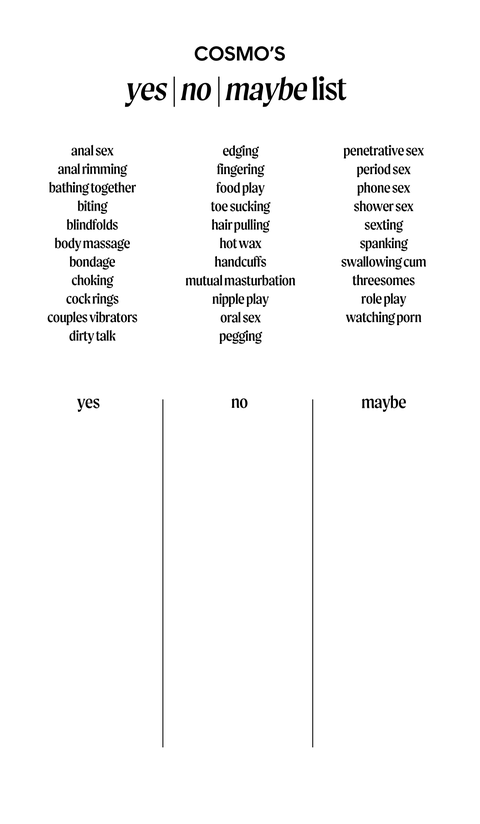If you received sex education at any point in your schooling, chances are you weren’t exactly taught to verbalize your sexual desires, especially if all you learned was Mean Girls-style, “Don’t have sex, ‘cause you will get pregnant and die.” A culture that conflates abstinence with sex education is one that stifles sexual expression, not one that gives you the space to practice saying “Spank me, mommy!” or “Treat me like a filthy cum dumpster!”
That’s why sometimes in the throes of passion with a partner—y’know, those times when there are things you really want to say or try—you might feel like you can’t. Whether it’s due to fear of rejection, what your partner might think, or sounding unsexy, it’s times like these when you could benefit from a Yes, No, Maybe sex list: a tool used by kinksters and BDSM practitioners for decades to establish ground rules and spark conversations around sexual needs.
“If you’re nervous about saying to someone, ‘I want to put my feet in your mouth,’ or ‘I want to peg you,’ [a Yes, No, Maybe list] can create a psychological buffer where no’s become less intensive and yeses become a jumping off point instead of a complete sentence,” kink coach Princess Kali, founder of KinkAcademy.com, says.
While traditional Yes, No, Maybe (YNM) lists are pretty straightforward (think spreadsheet-style, with three columns and a simple roster of activities), Kali recognizes this format is limited. A YNM list can help you identify not only which sex acts you want to explore, she says, but more importantly, which emotional experiences you want to have during sex—something she addresses in The Yes, No, Maybe Workbook, a resource she created to help folks find more nuance in their own lists.
But whether it’s a workbook, a spreadsheet, or scribbles in a drugstore notebook, sex educator Lola Jean, headmistress of the 7 Days of Domination school, says the concept of the YNM list provides you and your partners a foundation to build upon in whatever way suits you best. No matter your relationship status, a YNM list is an accessible resource that can illuminate information about your sexual desires in new ways—and help you ask for what you really want, instead of just swallowing it. Unless, of course, what you really want is to swallow it.
So, what is a Yes, No, Maybe list, and what is it not?
Pro dominatrix and kink educator Mistress Shayla Lange, owner of NYC’s largest woman-owned dungeon, defines a YNM list as “a list of kinks or fetishes that somebody brings to the table”—whether they’ve tried them before, read about them online, saw them in a movie, whatever. For example, on the list could be: being tied up, pegging, golden showers, and wax play. Maybe you would say “yes” to being tied up and golden showers, “no” to pegging, “maybe” to wax play, and so on. “Because it’s a graphic format—it’s written—it’s a good way to figure out where you and a partner line up and maybe where you don’t line up,” she explains. “You can say, ‘Okay, this is a green light, this is a green light, maybe we can talk about this one.’”
Kali explains that while the YNM list has its roots in the kink world, it’s a powerful negotiation tool that’s been expanded to encompass “a variety of sexual adventurers or sexual explorers,” not just kinksters. It’s even applicable to relationship styles. Polyamorous folks can use a YNM list to navigate their relationship boundaries. In a sexual context, even folks who are less experimental can create a version of the YNM list that includes traditional sex acts that they are or aren’t interested in.
And within that negotiation, there could be some caveats. Maybe you say, yes, you’re into pegging, but only under certain circumstances or only with certain toys.
One thing a YNM list is not? A binding agreement to do anything in particular, or an excuse to forgo ongoing discussions around consent. “It’s not a consent contract,” Jean clarifies. “Just because I said yes to this doesn’t mean it’s always on the table all the time. It’s not in lieu of a consent conversation.”
Is a Yes, No, Maybe list just for sex acts?
While your list can be a simple chart of sex acts, the experts recommend using the space to flesh out your “goal feelings,” or how you want sex to make you feel.
“I do want to feel small, but I don’t want to feel degraded, for example, or I do want to feel slutty, but I don’t want to feel used,” Lange says. “You can absolutely put those on a Yes, No, Maybe list.”
You could love getting attention but hate feeling pain, in which case, spanking would fall under your “no” column. “You can get attention in plenty of ways that don’t involve getting hit,” Jean explains, “but it can be confusing because it can start out feeling fun and different until you realize you’re putting up with the pain for this other feeling that you like.”
Listing goal feelings can also help you identify the contexts in which you like or don’t like certain acts. “With the example of spanking, most people associate it with punishment,” Kali says. “You’ve been a naughty girl and I’m gonna put you over my knee and I’m gonna punish you. And so that context may ruin something where the sensations are actually desirable, but the context is off for someone.”
So, how do you actually make a Yes/No/Maybe list?
When first experimenting with a YNM list, all three experts say you should start with your goal feelings, not necessarily what you want to do, because people have different associations with certain sex acts. “Do I want to feel degraded?” Lange says. “Do I want to feel overpowered? Do I want to feel taken care of? Using those feeling words can help navigate what actions or activities you’re going to put on your list.”
You and your partner write down all your goal feelings and the things you want to try at the top of your lists. (A pre-existing template version is helpful if you’re not coming to the table with things already in mind.) Then, individually, you’ll place each feeling and act into a Yes, No, or Maybe column. Once you’re both done, you’ll come together and compare lists.
Still confused? Worry not—we made one for you. Feel free to save it, print it, type on it, add more items, doodle on the sides…whatever you need to do to communicate to your heart’s desire.
It can be tempting to fill your list with every single kink and sex act you’ve ever heard of all at once, but the experts advise against it. Within each sex act or kink, there are different layers to explore, and tackling too many at once can be overwhelming. It’s also important to be clear about how, exactly, you want to try things out.
Take bondage, for example. Kali explains that someone who’s into bondage could like anything on the spectrum, from getting tied up with satin ribbons to being mummified with duct tape and only a tube to breathe through. Both qualify as bondage, she says, but it’s important to specify what bondage means to each of you—plus which materials you like and what ambiance feels best. “Even when you’re using the same words, you may not be speaking the same language,” she says.
She recommends limiting your first list to just three things per column (whether it’s kinks, activities, words, toys, etc.). This can help get the ball rolling without overwhelming you. “Eventually you may have six or seven different versions of your list, but you don’t have to figure it out all at once,” Kali says.
So I made a list. Now what?
The experts recommend tailoring your list to your specific partner. You can always revisit your list(s) on your own or with new partners to reflect changes in what you want and how you feel with them.
“Maybe your list looks different when you’re with a femme versus somebody who’s more masc-presenting, or maybe it’s different if someone’s older than you or younger,” Jean explains.
In terms of actually sharing your lists, Kali says it’s important to carve out some time for a discussion—not when you’re about to fall asleep, driving to pick up the kids, or in the middle of sex. And most importantly, be up front with your partner about your intentions.
“Before you launch into the list, really say to each other, ‘If I don’t want to do something, that’s not a rejection of you,’” Kali says. “Then be cognizant of how you give your no’s. Because if I’m talking with my lover and they say, ‘I want to suck your toes,’ and I say ‘ICK NO,’ that is a hurtful no. That is going to harm our dynamic, our relationship, our sexual experiences together, because of the way I said no, not that I said no.”
What if I’m scared of rejection?
For some people, sharing a private sexual desire with a partner might feel impossible—especially if they’ve never learned to embrace that desire within themselves. In that case, a YNM list may help you on your journey to self-acceptance, but it’s not going to magically melt away a lifetime of societal repression on its own.
“[The YNM list is] not a good venue to voice your kink with a partner before you’ve voiced it with yourself,” Lange says. “Practicing radical self-acceptance is a really important part of this, because if you are fearful of your own desires, you’re not going to be able to communicate your boundaries with somebody else.”
Whether it’s writing them in a journal, sending yourself a voice note, or reciting a morning affirmation (“I’m a cum dumpster and I’m proud!”), the more comfortable you are with your own kinks, the better you can communicate them to a partner. “If you can’t talk about it with yourself, […] then it’s going to be impossible to say it to a partner,” Lange says.
A fear of rejection is natural, especially when around sensitive subjects like your tightly kept sexual secrets. But Jean warns that a YNM list isn’t a mechanism to get your partner’s approval for the stuff that you’re into.
“No matter how much this other person loves you, thinks you’re hot, wants to f*ck you, whatever, they do not have to do your thing,” she says. “And that does not make your thing any less valid because they do not want to do it.”
What if my partner’s list and mine don’t match up?
“This is where the feelings come in,” Lange explains. Say your partner listed spanking, degradation, and hair-pulling as yeses, but the only thing you have on your list that matches with theirs is hair-pulling. Ask yourself why you like this one particular activity. Is it the sensation? Is it the emotion tied up in it?
“Once you find the feeling, you can find other things in that same vein,” Lange says. “It may lead you down an avenue that you might not have thought of, that’s not even on the list. Or it may help you to build a scene using the things that do overlap.”
On the flipside, Jean adds, their “no” might just be an invitation to dig deeper. If spanking is on your list and not on theirs, for example, ask why. If it’s because they don’t want to hurt you, suggest using a furry flogger or a foam bat that will never hurt no matter how hard they hit.
And remember: No’s are opening points too, Kali says. If you’re into spanking but your partner isn’t, use that as an opportunity to learn more about why, so that you’re not accidentally making them feel whatever it is that comes up for them with spanking in other ways.
Ultimately, a YNM list can help you excavate the precise language to describe your sexual desires—something very few people are given the tools to do when they start to need them.
“In my 20 years of experience, I think people don’t necessarily have a direct fetish or desire for actions or activities, they have a desire for emotional experiences and psychological releases,” Kali says. “And so a Yes, No, Maybe list can bring together actions, emotional contexts, and psychological nuance. And when you marry those things in a single communication tool, that’s where Yes, No, Maybe lists lead us to successful sexual experiences.”
Source: Read Full Article



